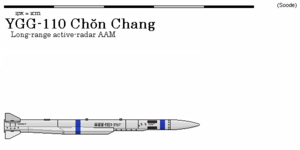YGG-110 Chŏn Chang
| YGG-110 "Chŏn Chang" | |
|---|---|
 Side view of a YGG-110 missile | |
| Type | Long-range active radar homing air-to-air missile |
| Place of origin | Menghe |
| Service history | |
| In service | 2020-present |
| Production history | |
| Manufacturer | Gwŏn-un |
| Variants | YGG-110G |
| Specifications | |
| Weight | 210 kg |
| Length | 3.92 m |
| Diameter | 200 mm |
| Warhead | 30 kg HE fragmenting |
Detonation mechanism | Laser proximity fuse |
| Engine | solid-fuel ramjet |
| Wingspan | 730 mm |
Operational range | 200-300 km |
| Speed | Over Mach 4 |
Guidance system | command and inertial guidance, terminal active radar homing |
Launch platform | |
The YGG-110 Chŏn Chang (Menghean: "Sky Spear") is a type of active radar guided beyond-visual-range air-to-air missile developed in Menghe. It is powered by a solid-fuel ramjet sustainer engine with a solid-fuel nozzleless booster stage, allowing it to achieve a considerably greater range than the YGG-7 Hwasal. Official Menghean press releases claim that the YGG-110 has twice the range of the YGG-7, and a no-escape zone three times as large, suggesting a range of at least 200 kilometers and possibly more.
Design
Seeker
Like the YGG-7, the YGG-110 relies on active radar for terminal guidance, but uses a mix of inertial guidance and command guidance to approach the target in the initial phase. In command mode, the launch aircraft illuminates the target with its radar, fires the missile, and sends datalinked commands to update the missile's course in order to intercept the target. In inertial mode, the missile follows a blind trajectory toward a pre-programmed intercept point and activates its seeker at a pre-set distance. Inertial mode is used at very short ranges and in jamming-heavy environments.
The YGG-110 reportedly uses an active phased array radar antenna in a new seeker head. This seeker has a wider angle of view than conventional seeker types, increasing the size of the "basket" in which the missile can autonomously acquire a target. This, in turn, increases the probability of a successful terminal-stage lock, especially when the launch platform has to break lock during the missile's final approach. Official sources also claim that the YGG-7's seeker is more resistant to jamming.
Propulsion
The YGG-110's long range is a product of its advanced propulsion system, which consists of a solid-fuel ramjet with two rhomboidal intakes under the missile body. The use of solid fuel simplifies logistics, storage, and maintenance, and the use of a ramjet engine allows for greatly increased efficiency. The advanced propulsion unit was one of the main sources of delays in the development of the YGG-110.
In storage and on the ground, the YGG-110's intakes are sealed off. Immediately after launch, a solid propellant booster accelerates the missile to supersonic speeds, at which point the air intakes open and the ramjet takes over. The boron-rich propellant has a high specific impulse, resulting in higher efficiency and greater range. Because the missile can pursue an overtaken target over a longer distance and maintain its speed more effectively, the YGG-110 has a large no-escape zone, i.e. the range at which a maneuvering target cannot leave the missile's range before the missile makes contact.
Datalink
The two-way datalink at the base of the YGG-110 receives commands from the launch aircraft and transmits back information from the inertial guidance unit and the seeker. Forward transmission allows for mid-course updates and command guidance, particularly useful when engaging a maneuvering target, and back transmission from the seeker alerts the pilot when the missile goes active, when it locks the target, and, by ending transmission, when it detonates.
The back-transmission from the inertial guidance unit also provides the pilot and launch plane with an indication of where the missile is. In theory, this could allow a plane to launch a YGG-110 at long range while keeping its own radar turned off, or while facing away from the target, as long as another platform provides range and bearing information to the launch plane via datalink. This technique could be used to engage targets without giving away the launch plane's location or alerting the target with a radar lock, though it would trigger the target's missile approach warning system once the missile is close.
Two-way datalink communication also allows the pilot to re-assign the missile to a new target in flight, useful if the initial target evaded, disappeared, or was destroyed by another weapon. A "stand down" command, manually activated by the pilot, disarms the missile and sends it on a vertical descent. This mode can be activated in the event of friendly fire, accidental discharge, or de-escalation in a limited engagement.
Operational service
As of early 2021, the YGG-110 is believed to be in low-rate production. The ram combustor components, particularly the adjustable throat area nozzle, were believed to be the main bottleneck in development, with unconfirmed reports that Gwŏn-un changed suppliers after finding faults in parts supplied for the first test units. A press release in late 2020 stated that the YGG-110 would enter high-rate production before the end of 2022, though independent analysts have expressed doubts about this claim.
There are currently no plans to export or license the YGG-110, due to the sensitive nature of its technology and the lack of official confirmation on its range and performance envelope.